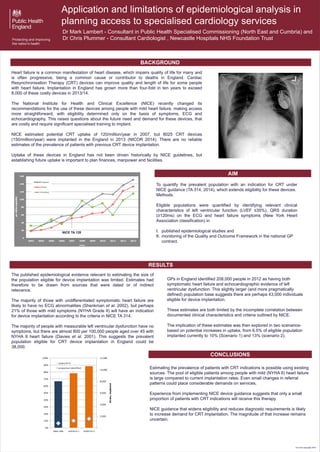
Cardiac Devices Presentationv3-1
- 1. © Crown copyright 2015 BACKGROUND AIM RESULTS CONCLUSIONS NICE TA 120 Heart failure is a common manifestation of heart disease, which impairs quality of life for many and is often progressive, being a common cause or contributor to deaths in England. Cardiac Resynchronisation Therapy (CRT) devices can improve quality and length of life for some people with heart failure. Implantation in England has grown more than four-fold in ten years to exceed 8,000 of these costly devices in 2013/14. The National Institute for Health and Clinical Excellence (NICE) recently changed its recommendations for the use of these devices among people with mild heart failure, making access more straightforward, with eligibility determined only on the basis of symptoms, ECG and echocardiography. This raises questions about the future need and demand for these devices, that are costly and require significant specialised training to implant. NICE estimated potential CRT uptake of 120/million/year in 2007, but 8025 CRT devices (150/million/year) were implanted in the England in 2013 (NICOR 2014). There are no reliable estimates of the prevalence of patients with previous CRT device implantation. Uptake of these devices in England has not been driven historically by NICE guidelines, but establishing future uptake is important to plan finances, manpower and facilities. To quantify the prevalent population with an indication for CRT under NICE guidance (TA 314, 2014), which extends eligibility for these devices. Methods. Eligible populations were quantified by identifying relevant clinical characteristics of left ventricular function (LVEF ≤35%), QRS duration (≥120ms) on the ECG and heart failure symptoms (New York Heart Association classification) in I. published epidemiological studies and II. monitoring of the Quality and Outcome Framework in the national GP contract. The published epidemiological evidence relevant to estimating the size of the population eligible for device implantation was limited. Estimates had therefore to be drawn from sources that were dated or of indirect relevance. The majority of those with undifferentiated symptomatic heart failure are likely to have no ECG abnormalities (Shenkman et al. 2002), but perhaps 21% of those with mild symptoms (NYHA Grade II) will have an indication for device implantation according to the criteria in NICE TA 314. The majority of people with measurable left ventricular dysfunction have no symptoms, but there are almost 800 per 100,000 people aged over 45 with NYHA II heart failure (Davies et al. 2001). This suggests the prevalent population eligible for CRT device implantation in England could be 38,000. Application and limitations of epidemiological analysis in planning access to specialised cardiology services Dr Mark Lambert - Consultant in Public Health Specialised Commissioning (North East and Cumbria) and Dr Chris Plummer - Consultant Cardiologist , Newcastle Hospitals NHS Foundation Trust GPs in England identified 208,000 people in 2012 as having both symptomatic heart failure and echocardiographic evidence of left ventricular dysfunction. This slightly larger (and more pragmatically defined) population base suggests there are perhaps 43,000 individuals eligible for device implantation. These estimates are both limited by the incomplete correlation between documented clinical characteristics and criteria outlined by NICE. The implication of these estimates was then explored in two scenarios- based on potential increases in uptake, from 6.5% of eligible population implanted currently to 10% (Scenario 1) and 13% (scenario 2). Estimating the prevalence of patients with CRT indications is possible using existing sources. The pool of eligible patients among people with mild (NYHA II) heart failure is large compared to current implantation rates. Even small changes in referral patterns could place considerable demands on services. Experience from implementing NICE device guidance suggests that only a small proportion of patients with CRT indications will receive this therapy. NICE guidance that widens eligibility and reduces diagnostic requirements is likely to increase demand for CRT implantation. The magnitude of that increase remains uncertain.